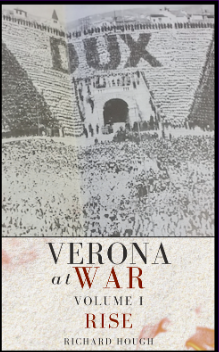|
Sunday 14 June 2015 is Bomba Day in Verona. A recently discovered 500lb Second World War bomb will be detonated in Verona on Sunday morning. The bomb was discovered during excavation works for the construction of a new car park near the city’s historic military arsenal. On Sunday between the hours of 0800 and 1200, a significant part of the city will be in lockdown. Some 27,000 residents within a 700 metre radius (the Zona Rosa) will be evacuated while military bomb disposal experts defuse the device. Although the evacuation is a precautionary measure, failure to comply could result in a €200 fine. Those who live in the ‘Orange Zone’ (between 700 and 1000 metres from the bomb site) are permitted to remain at home, but, for safety reasons, are instructed to stay away from windows and balconies. In addition to the permanent residents, there are over 50 hotels and guest houses within the Zona Rosa, accommodating between 5,000 and 10,000 guests. For the hotels concerned, the evacuation is a considerable inconvenience in what is, after all, the high summer season. The Zona Rosa also includes important tourist sites Castelvechio and the Basilica San Zeno, while the Orange Zone reaches as far as the city’s iconic Arena. Personally, I’m not taking any chances and will be spending the weekend in Tuscany! This being Italy, though, there are of course those who intend to ignore the evacuation order. The local media has already reported that the elderly of the zone are particularly reluctant to leave their homes. Their attitude seems to be that they didn’t leave the city during the war and they are not going to do evacuate now. They’ll simply close their shutters tight and hope for the best. The American made bomb is thought to have been dropped by the Allies in July 1944 in one of the numerous bombardments of the city. Quite possibly, an AN-M64 General Purpose Bomb, it was particularly suitable against ammunition dumps, railway engines and cars, airplanes on the ground, all types of construction and light surface vessels. Few Italian cities escaped the terror of arial bombardment during the Second World War. According to official ISTAT statistics, there were around 60,000 civilian casualties of bombing during World War II. More recent research suggests that the figure may in fact be closer to 80,000. Because of her important strategic position as the southern gateway to the crucial Brenner route through the Alps, Verona was an important target for heavy Allied bombings and suffered considerable damage during the war. According to Italy’s Sorrow (by @jamesholland), by the beginning of 1945 the Brenner pass was the most heavily defended complex in the world and losses of allied aircraft were high. On 6 July 1944, twenty-eight aircraft dropped 84 tons of 500-lb bombs on the Marshalling Yards of Verona. The target was well covered with only a few bombs short. Flak was heavy, medium to intense, and inaccurate. Three to four EIA attacked the formation before being engaged by the escort. One of B-17 Flying Fortress bombers near the rear of the formation was seen to go down and explode. Three or four chutes were reported seen. Sergeant Smith was the tailgunner. He died along with 8 crew. Two of his comrades survived to tell the story… 1st Lt. William L. McIlhargie: "I was blown out of the plane, unconscious. I came to the following Saturday afternoon and have no knowledge of the others. I saw Sgt. Alexo, the radio man, last. He had a flak wound in his leg and it didn't look good. There wasn't time to give him first aid. I had just arrived there for that reason, then the ship blew up and that is all I remember. The last conversation I had with Lt. Runyon was to ask permission to go back and give first aid to the radio operator." S/Sgt. Paul Alexo, Jr., Radio Operator: "I was blown out of the plane with two others when the plane blew up. S/Sgt. Smith had received a 20mm wound in his chest and was blown out. He died on the ground. I saw him in the hospital, dead. Lt. Runyon did not get out. Sgt. Goulet was killed by a 20mm shell and was last seen lying on the floor of the plane. Sgt. Brower-Anchor was killed by a 20mm shell in his back and was lying on the floor, dead. S/Sgt. Miller was last seen at his guns when the ship exploded." In 1989, two letters that tailgunner Sergeant Smith had written before his death in the skies above Verona were finally delivered to his surviving brother in Utah. They had got lost in transit and had somehow spent decades in storage in an attic in North Carolina. William McIlhargie died on 3 October 2005 at Northwood Meadows in Cass City. He received the Purple Heart along with several other service awards for his bravery during the Second World War. A subsequent raid by Martin B-26 Marauders, a twin-engined, 6-manned, medium bomber, took place on 13 July 1944. Sergeant Ernest Wall from Edinburgh was one of those who flew the Marauder over Verona in July 1944. From an operational airfield at Pescara on the Adriatic, his first operation on 11 July 1944 was aborted due to bad weather (not unusual in North Italy). Subsequent targets were marshalling yards, road/rail junctions, and bridges over the River Adige, and all over the northern battleground area. Among the targets were factories and German HQs. As the Marauders flew slowly and at low altitude above their drop zones, they were a prime target for anti-aircraft flak and most returned to base with holes. Many did not return. The Marauder were often escorted by Spitfires, Kittyhawks or Mustangs and must have been an awesome but terrifying site for the residents below. Indeed, in a recent article in a local newspaper, geographer and journalist Eugenio Turri Veronese, then only a child, described the terrible moments experienced by the citizens of the city when the Allied planes arrived: "You could hear a distant rumble that made the windows vibrate and the objects on the dresser rattle. All of a sudden, life is awakened, with a shock. The panic reaches a peak with women weeping and the old reciting the rosary. The American planes brought fear to the neighbourhood, the apocalypse ... ". The account presented in the local newspaper, l’Arena, on 13 July 1944, offers a somewhat different perspective, suggesting that while the raid targeted residential housing and a nursery school, there were few victims because the population promptly took refuge in shelters and the emergency services were, as always, ready and worked with dedication, technical skills and organisation. This account seems barely credible as one only has to only has to look at pictures taken at the time and listen to first hand accounts to understand the full extent of the destruction. Following extensive reconstruction in the postwar period, there are few remaining signs of the bombardment of Verona during the Second World War. But, if you look closely at buildings like the one on Piazza Pradaval (opposite the former SS Headquarters), you will see by the door a fading sign, white letters on a red background “RC” (rifugio civile). This sign indicates a shelter were the residents of Verona could take take cover during an air raid. The bomb discovered near Verona's historic military arsenal is of course another reminder of the devastation and destruction that took place here and throughout Italy during the Second World War.
I am grateful to the Second Bombardment Association for the account of its account of the bombardment of Verona and the staff at Biblioteca Civica di Verona for helping me to access newspaper records from the time. You can read about Ernest Wall in Italy's Sorrow. Further details were found at: http://www.aircrew-saltire.org/lib010.htm
|
AboutRichard Hough writes about history, football, wine, whisky, culture + travel and is currently working on a trilogy about wartime Verona.
|







